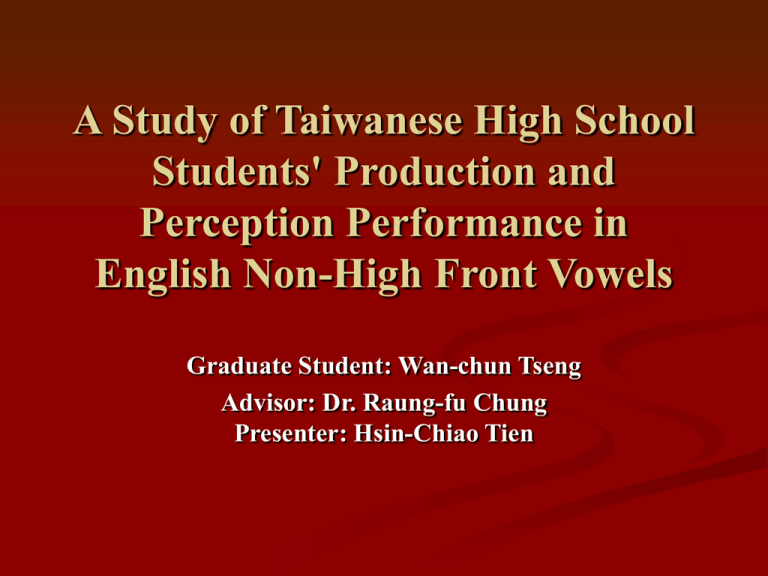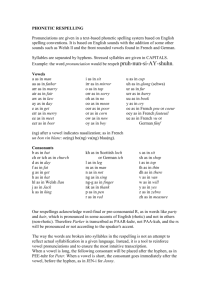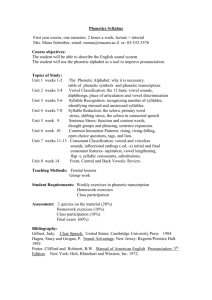A Study of Taiwanese High School Students' Production and Perception Performance in
advertisement

A Study of Taiwanese High School Students' Production and Perception Performance in English Non-High Front Vowels Graduate Student: Wan-chun Tseng Advisor: Dr. Raung-fu Chung Presenter: Hsin-Chiao Tien Background and Motivation Communicative Language Teaching (CLT) Orally communicate General English Proficiency Test Pairs of tense-lax vowels often cause frustration and confusion Purpose of the Study To investigate Taiwanese senior high school students’ performance in their production and perception of the English front vowels /E//e//A/ Research Questions of the Study 1. Can the subjects identify the three front vowels /E//e/and /A/? 2. How is the subjects’ performance of their pronunciation of / E /, /e/ and / A /? 3. In what range is the subjects’ performance of production intelligible for English native speakers? Subjects 72 males and 30 females in the 3rd grade of senior high school. Mandarin and Southern Min are the languages they use the most often in ordinary conversation. High achievement English learners (HAE): English scores in GSAT were 10 and upward Low achievement English learners (LAE): English scores in GSAT were under 10 Instruments: Questionnaire Part one: personal data 1)birthplaces 2)native tongues 3)the language they and their parents use most often Part two: English learning experience 1)the year of learning English 2)the acquisition of English before junior high school 3)the experience of going abroad 4)other extracurricular sources of learning English 5)the experience of learning K.K phonetic symbols and going to a cram school Instruments: The Perception Experiment Each of the two native speakers read and recorded 9 sentences. The total 18 sentences were then doubled as 36 files and organized in random order. The 9 items were marked as A to I. There were 36 blanks for the subjects to fill in what they heard from the listening process. The K.K. phonetic symbols of the 9 items were also shown. Instruments: The Production Experiment Oral reading text: a word list with 20 single words, 5 sentences, and 1 short passage Including / E ,e, A / in different phonetic environments: open syllables, closed syllables with a following voiced consonant and voiceless consonant. The Main Findings: Perception 1.The three front vowels are challenging for English learners in Taiwan to distinguish, / E / in particular. / A / is the easiest one to perceive. 2.The vowel / e / in closed syllable with a voiceless consonant is more difficult to be aware of than that in the other two phonetic environments. 3. The vowel / E / in closed syllable with a voiced consonant is more difficult to be aware of than that in the other two phonetic environments. The Main Findings: Perception 4. The vowel / A / in open syllable is more difficult to be aware of than that in the other two phonetic environments. 5. Those who did better on the written test of English —GSAT— also performed better on the perception task of English. The Main Findings: Production 1. The vowel / e / displays the most difficulty in the subjects’ production and the greatest success in pronouncing /A/. 2. The vowel / e / The vowel / e / in the closed syllable with a voiceless consonant displays more errors. The Main Findings: Production 3. The vowel / E / The vowel / E / in the closed syllable with a voiceless consonant displays more errors . 4. The vowel / A / The vowel / A / in the closed syllable with a voiceless consonant displays more errors. The Main Findings: intelligible ranges 1.The ranges in vowel length appear wide. The length of the vowel / E / and / A / can be longer than each other, while that of / e / has to be the longest of the three vowels. 2.LAE’s performance of tongue height tended to stay raised, MLAE in particular, fossilizing their tongue position more. The Main Findings: intelligible ranges 3. The tongue advancement of / A / does not matter much, while the tongue advancement of / e / must be anterior to that of / E /. MHAE tended to move their tongue more forward and the female subjects tended to keep their tongues farther back. Pedagogical Implications While advancing learners’ listening skill, instructors have the duty to raise their awareness of the sounds they hear. Learners should be taught to pull the lip corners sideward and not to draw their jaws downward too far for / e /. Learners should be taught to draw their jaws open and press the tongues down for / A /. Pedagogical Implications Precise articulation and correct grammar knowledge are still essential for efficient development of communicative skills. Instructors of beginners are encouraged to put in more time on drills to form good pronunciation and sense of structures. High school teachers must help students to integrate all the language skills even though there are only written tests for English in the college entrance exams. Suggestions for Further Study Subjects’ language instructors should be taken into consideration. The listening task should be designed in a parallel way to the reading list. /a/ can be added to the target vowels to make more comparisons. THE END Thank you for listening!



